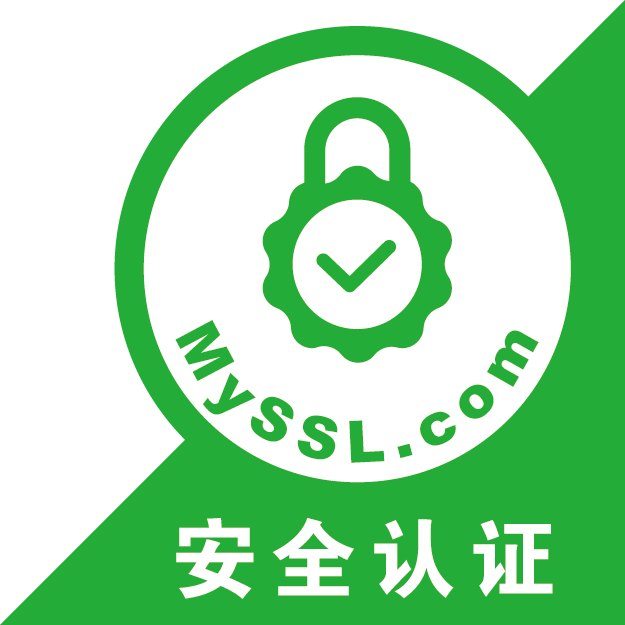IdentityServer4实现单点登录统一认证
开发环境:
vs2017、net Core 2.1、sqlserver2008、IdentityServer4版本2.4.0。
一、搭建IdentityServer4服务端
打开VS2017,新建 netcore项目: 名字叫:IdentityS4, 然后选择webMVC这个,如下图:
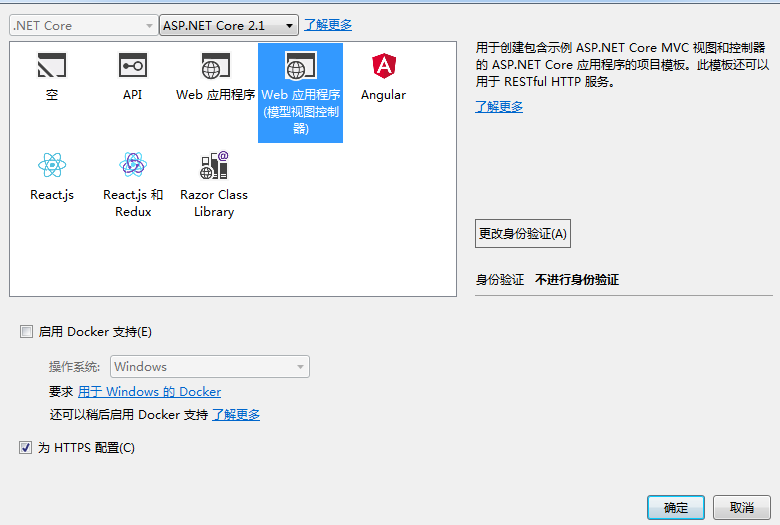
引进安装依赖项:IdentityServer4
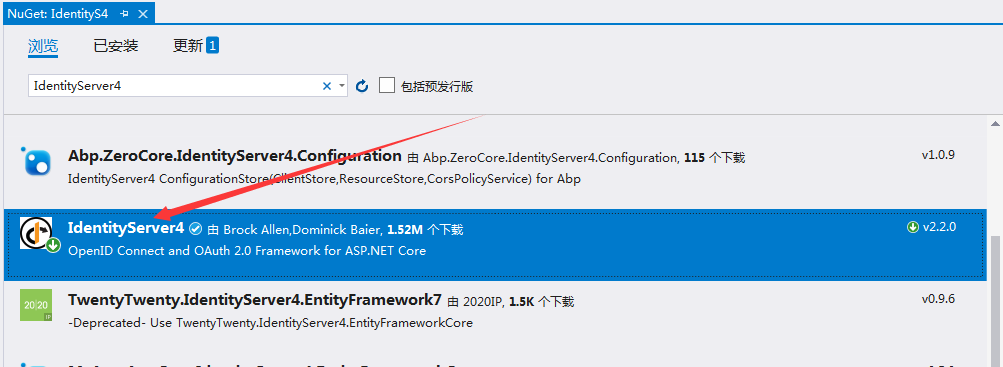
设置该项目的地址为:http://localhost:5000
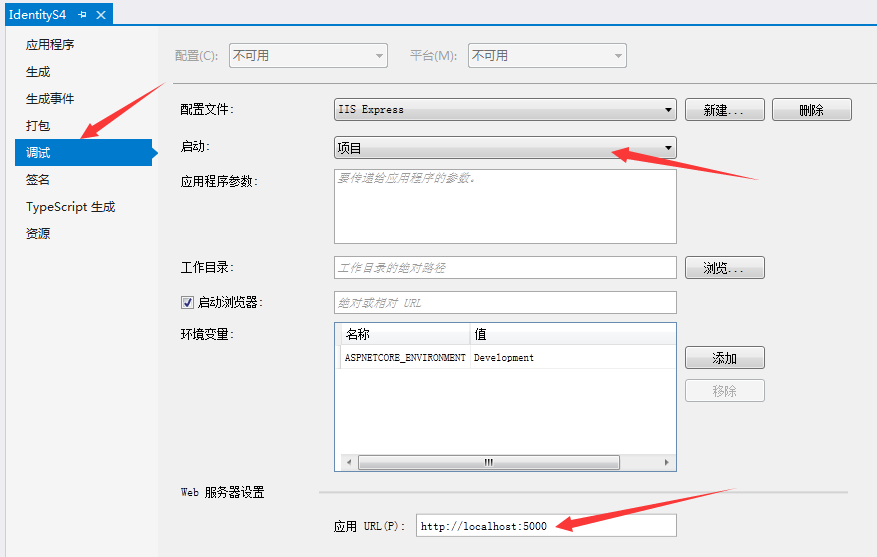
1、新建一个配置文件类:Config.cs 代码如下:
using IdentityServer4;
using IdentityServer4.Models;
using System;
using System.Collections.Generic;
using System.Linq;
using System.Threading.Tasks;
namespace IdentityS4
{
public class Config
{
// scopes define the resources in your system
public static IEnumerable<IdentityResource> GetIdentityResources()
{
return new List<IdentityResource>
{
new IdentityResources.OpenId(),
new IdentityResources.Profile(),
};
}
// clients want to access resources (aka scopes)
public static IEnumerable<Client> GetClients()
{
return new List<Client>
{
// OpenID Connect隐式流客户端(MVC)
new Client
{
ClientId = "mvc",
ClientName = "MVC Client",
AllowedGrantTypes = GrantTypes.Implicit,//隐式方式
RequireConsent=false,//如果不需要显示否同意授权 页面 这里就设置为false
RedirectUris = { "http://localhost:5002/signin-oidc" },//登录成功后返回的客户端地址
PostLogoutRedirectUris = { "http://localhost:5002/signout-callback-oidc" },//注销登录后返回的客户端地址
AllowedScopes =//下面这两个必须要加吧 不太明白啥意思
{
IdentityServerConstants.StandardScopes.OpenId,
IdentityServerConstants.StandardScopes.Profile
}
}
};
}
}
}
在Startup.cs的ConfigureServices方法中注入Ids4服务,如下面红色部分代码:
public void ConfigureServices(IServiceCollection services)
{
services.AddMvc().SetCompatibilityVersion(CompatibilityVersion.Version_2_1);
services.AddIdentityServer()//Ids4服务
.AddDeveloperSigningCredential()
.AddInMemoryIdentityResources(Config.GetIdentityResources())
.AddInMemoryClients(Config.GetClients());//把配置文件的Client配置资源放到内存
}
在Startup.cs的Configure方法中添加ids4服务中间件(注意要放在UseMvc之前就可以):
app.UseIdentityServer();
现在ids4本身的基本的配置弄好了,下面我们要开始弄跟数据库相关的东西了,大家想想,既然要登录,那肯定需要连接数据库并且读取出其中的用户信息去验证,比如账号、密码。好的,那我们就按照下面一步一步来做
添加DbContext类 名字叫:EFContext.cs ,代码如下(其中红色部分是我们待会需要添加的实体类,也就是对应数据库里面的用户表Admin,并添加实体类对应红色部分):
public class EFContext : DbContext { public EFContext(DbContextOptions<EFContext> options) : base(options) { } #region 实体集 public DbSet<Admin> Admin { get; set; }//注意 这里这个Admin不能写成Admins否则会报错找不到Admins 因为我们现在数据库和表是现成的 这里就相当于实体对应的数据库是Admin #endregion } public class Admin { public int Id { get; set; } public DateTime CreateDate { get; set; } public string UserName { get; set; } public string Password { get; set; } public string Remark { get; set; } }
数据库建立Admin表
/* Navicat SQL Server Data Transfer Source Server : 轻量应用服务器 Source Server Version : 100000 Source Host : 120.79.21.96 :1433 Source Database : test Source Schema : dbo Target Server Type : SQL Server Target Server Version : 100000 File Encoding : 65001 Date: 2019-05-22 09:56:13 */ -- ---------------------------- -- Table structure for Admin -- ---------------------------- DROP TABLE [dbo].[Admin] GO CREATE TABLE [dbo].[Admin] ( [Id] int NOT NULL , [CreateDate] datetime NULL , [UserName] nvarchar(MAX) NULL , [Password ] nvarchar(MAX) NULL , [Remark] nvarchar(MAX) NULL ) GO -- ---------------------------- -- Records of Admin -- ---------------------------- INSERT INTO [dbo].[Admin] ([Id], [CreateDate], [UserName], [Password ], [Remark]) VALUES (N'1', N'2019-05-21 18:05:52.000', N'test', N'123456', N'测试账号') GO GO
在Startup.cs的ConfigureServices方法中注入 EFContext,如下面红色部分代码:
public void ConfigureServices(IServiceCollection services) { services.AddDbContext<EFContext>(options=>options.UseSqlServer(Configuration.GetConnectionString("conn")));//注入DbContext services.AddMvc().SetCompatibilityVersion(CompatibilityVersion.Version_2_1); services.AddIdentityServer()//Ids4服务 .AddDeveloperSigningCredential() .AddInMemoryIdentityResources(Config.GetIdentityResources()) .AddInMemoryClients(Config.GetClients());//把配置文件的Client配置资源放到内存 }
接下来,我们就要写Admin这个实体类跟数据库打交道的代码了,比如增删改查啊,在net中一般交DAL层,在netCore中 一般交services层,要注意的是 netcore的框架是IOC的框架,依赖注入的,所以这个services层需要接口的形式!
新建一个接口:IAdminService.cs 代码如下:
public interface IAdminService
{
Task<Admin> GetByStr(string username, string pwd);//根据用户名和密码查找用户
}
新建实现该接口的类AdminService.cs
public class AdminService:IAdminService
{
public EFContext db;
public AdminService(EFContext _efContext)
{
db = _efContext;
}
/// <summary>
/// 验证用户,成功则返回用户信息,否则返回null
/// </summary>
/// <param name="username"></param>
/// <param name="pwd"></param>
/// <returns></returns>
public async Task<Admin> GetByStr(string username, string pwd)
{
Admin m=await db.Admin.Where(a => a.UserName == username && a.Password == pwd).SingleOrDefaultAsync();
if (m!=null)
{
return m;
}
else
{
return null;
}
}
}
在Startup.cs的ConfigureServices方法中注入 service层,如下面红色部分代码:
public void ConfigureServices(IServiceCollection services) { services.AddDbContext<EFContext>(options=>options.UseSqlServer(Configuration.GetConnectionString("conn")));//注入DbContext services.AddMvc().SetCompatibilityVersion(CompatibilityVersion.Version_2_1); services.AddIdentityServer()//Ids4服务 .AddDeveloperSigningCredential() .AddInMemoryIdentityResources(Config.GetIdentityResources()) .AddInMemoryClients(Config.GetClients());//把配置文件的Client配置资源放到内存 services.AddTransient<IAdminService,AdminService>();//service注入 }
在配置文件appsettings.json中添加数据库连接字符串如下红色部分代码:
{
"ConnectionStrings": {
"conn": "server=120.79.21.96 ;database=test;user=sa;password=Sa123456;"
},
"Logging": {
"LogLevel": {
"Default": "Warning"
}
},
"AllowedHosts": "*"
}
至此,应该是可以正确的连接数据库的,大家可以去Home控制器中查询点数据测试下显示到首页,保证能连接数据库成功的查询出数据就可以。
接下来 我们来做登录页面
using System;
using System.Collections.Generic;
using System.Linq;
using System.Threading.Tasks;
using IdentityS4.Models;
using IdentityServer4.Services;
using IdentityServer4.Stores;
using Microsoft.AspNetCore.Authentication;
using Microsoft.AspNetCore.Http;
using Microsoft.AspNetCore.Mvc;
namespace IdentityS4.Controllers
{
public class AccountController : Controller
{
private IAdminService _adminService;//自己写的操作数据库Admin表的service
private readonly IIdentityServerInteractionService _interaction;
private readonly IClientStore _clientStore;
private readonly IAuthenticationSchemeProvider _schemeProvider;
private readonly IEventService _events;
public AccountController(IIdentityServerInteractionService interaction,
IClientStore clientStore,
IAuthenticationSchemeProvider schemeProvider,
IEventService events,
IAdminService adminService)
{
_interaction = interaction;
_clientStore = clientStore;
_schemeProvider = schemeProvider;
_events = events;
_adminService = adminService;
}
/// <summary>
/// 登录页面
/// </summary>
[HttpGet]
public async Task<IActionResult> Login(string returnUrl = null)
{
ViewData["returnUrl"] = returnUrl;
return View();
}
/// <summary>
/// 登录post回发处理
/// </summary>
[HttpPost]
public async Task<IActionResult> Login(string userName, string password, string returnUrl = null)
{
ViewData["returnUrl"] = returnUrl;
Admin user = await _adminService.GetByStr(userName, password);
if (user != null)
{
AuthenticationProperties props = new AuthenticationProperties
{
IsPersistent = true,
ExpiresUtc = DateTimeOffset.UtcNow.Add(TimeSpan.FromDays(1))
};
await HttpContext.SignInAsync(user.Id.ToString(), user.UserName, props);
if (returnUrl != null)
{
return Redirect(returnUrl);
}
return View();
}
else
{
return View();
}
}
}
}
添加登录view视图,代码如下:
@{
Layout = null;
}
<!DOCTYPE html>
<html>
<head>
<meta name="viewport" content="width=device-width" />
<title>Login</title>
</head>
<body>
<div align="center">
<h1>统一认证登录中心</h1>
<form action="/Account/Login" method="post">
用户名:<input type="text" name="userName" /><br />
密 码:<input type="password" name="password" /><input type="hidden" name="returnUrl" value="@ViewData["returnUrl"]" /> <br />
<input type="submit" value="登录" />
</form>
</div>
</body>
</html>
至此,IdentityServer4服务端的工作完成,粘贴全部代码即一个重要文件文件代码(Startup.cs) 主要看摆放位置
Startup.cs
using System;
using System.Collections.Generic;
using System.Linq;
using System.Threading.Tasks;
using IdentityS4.Models;
using Microsoft.AspNetCore.Builder;
using Microsoft.AspNetCore.Hosting;
using Microsoft.AspNetCore.Http;
using Microsoft.AspNetCore.HttpsPolicy;
using Microsoft.AspNetCore.Mvc;
using Microsoft.EntityFrameworkCore;
using Microsoft.Extensions.Configuration;
using Microsoft.Extensions.DependencyInjection;
namespace IdentityS4
{
public class Startup
{
public Startup(IConfiguration configuration)
{
Configuration = configuration;
}
public IConfiguration Configuration { get; }
// This method gets called by the runtime. Use this method to add services to the container.
public void ConfigureServices(IServiceCollection services)
{
services.AddDbContext<EFContext>(options => options.UseSqlServer(Configuration.GetConnectionString("conn")));//注入DbContext
services.Configure<CookiePolicyOptions>(options =>
{
// This lambda determines whether user consent for non-essential cookies is needed for a given request.
options.CheckConsentNeeded = context => true;
options.MinimumSameSitePolicy = SameSiteMode.None;
});
services.AddMvc().SetCompatibilityVersion(CompatibilityVersion.Version_2_1);
services.AddIdentityServer()//Ids4服务
.AddDeveloperSigningCredential()
.AddInMemoryIdentityResources(Config.GetIdentityResources())
.AddInMemoryClients(Config.GetClients());//把配置文件的Client配置资源放到内存
services.AddTransient<IAdminService, AdminService>();//service注入
}
// This method gets called by the runtime. Use this method to configure the HTTP request pipeline.
public void Configure(IApplicationBuilder app, IHostingEnvironment env)
{
app.UseIdentityServer();
if (env.IsDevelopment())
{
app.UseDeveloperExceptionPage();
}
else
{
app.UseExceptionHandler("/Home/Error");
app.UseHsts();
}
app.UseHttpsRedirection();
app.UseStaticFiles();
app.UseCookiePolicy();
app.UseMvc(routes =>
{
routes.MapRoute(
name: "default",
template: "{controller=Home}/{action=Index}/{id?}");
});
}
}
}
接下来我们要开始建客户端了,也就是需要保护的MVC网站
二、搭建客户端
新建一个名为 MvcClient 的
把地址设置为:http://localhost:5002
在Startup.cs的ConfigureServices方法中添加如下红色部分代码(主要用来配置认证中心ids4的及自己作为客户端的认证信息):
public void ConfigureServices(IServiceCollection services)
{
JwtSecurityTokenHandler.DefaultInboundClaimTypeMap.Clear();
services.AddAuthentication(options =>
{
options.DefaultScheme = "Cookies";
options.DefaultChallengeScheme = "oidc";
})
.AddCookie("Cookies")
.AddOpenIdConnect("oidc", options =>
{
options.SignInScheme = "Cookies";
options.Authority = "http://localhost:5000";
options.RequireHttpsMetadata = false;
options.ClientId = "mvc";
options.SaveTokens = true;
});
services.AddMvc().SetCompatibilityVersion(CompatibilityVersion.Version_2_1);
}
在 Configure方法中添加这行代码(需要在UseMvc之前就可以):
app.UseAuthentication();
到此,客户端跟统一认证的信息就配置完了。接下来我们把Home控制器上面加上需要验证的标志:[Authorize]
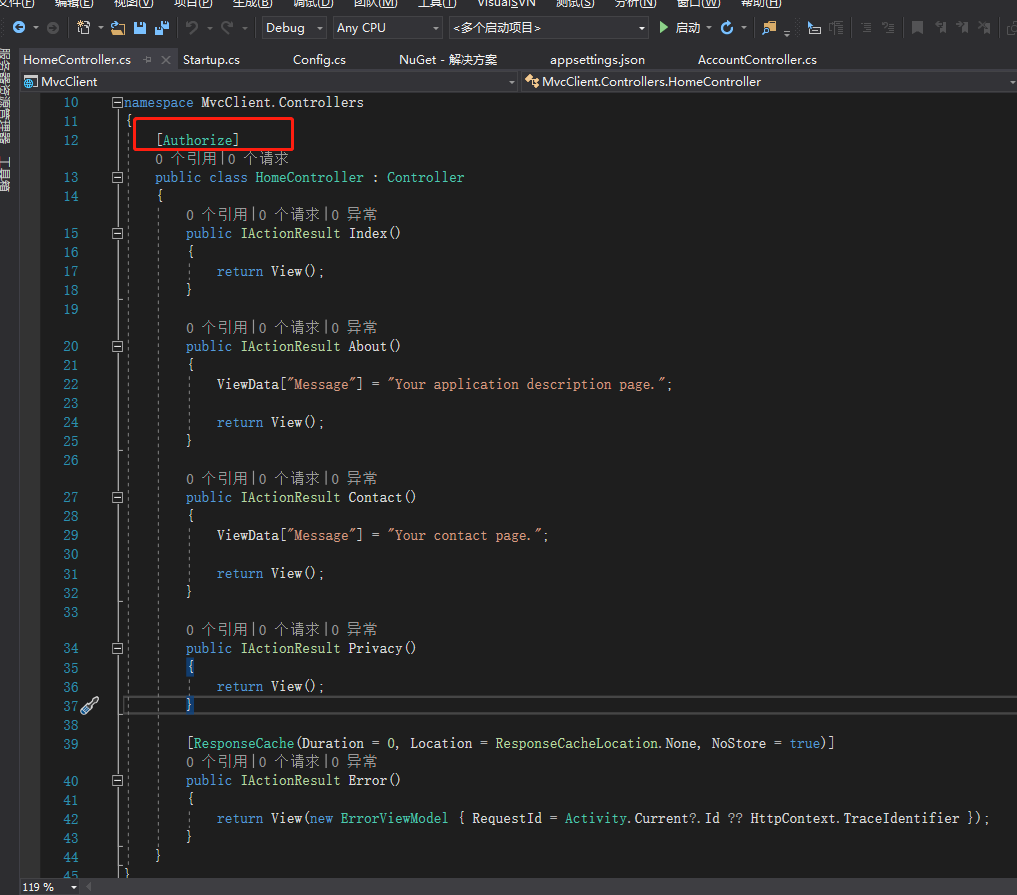
我们把默认的Index视图页面html代码去掉,改成如下(主要用来显示下授权后拿到的用户信息):
@{
ViewData["Title"] = "Home Page";
}
<div align="center"><h1>这里是受保护的客户端首页</h1></div>
<h3>User claims</h3>
<dl>
@foreach (var claim in User.Claims)
{
<dt>@claim.Type</dt>
<dd>@claim.Value</dd>
}
</dl>
到此,客户端的工作也做完了,下面我们要开始启动项目了
设置项目为多项目启动:解决方案上右键-属性
现在我们启动项目:服务器项目和 客户端都运行了,但是客户端会直接跳转到服务端登录页面
服务端
客户端(5002)跳转过来的登录页面:
然后输入正确账号密码 点击登录认证通过之后就跳转回 客户端网站去了
至此 ,例子结束!
从这个例子中,咱们可以再加几个客户端网站,然后统一到这个ids4认证,这样就达到了单点登录统一认证的效果了!
